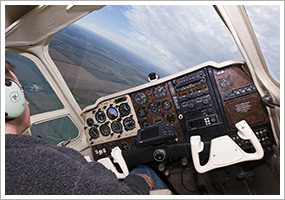Custom content from the Nov. 12, 2010, issue of 'AOPA ePilot' newsletter
| The following stories from the Nov. 12, 2010, edition of AOPA ePilot were provided to AOPA members who expressed an interest in the particular subject areas. Any AOPA member can receive information tailored to their areas of interest by updating their preferences online |
training tipsTypes of turns For routine course changes, or turns in the traffic pattern, a medium bank angle will suffice. When practicing minimum controllable airspeed flight, a shallow bank is all you can “afford.” When flying a ground reference maneuver, steepen your bank angle as groundspeed increases. For every in-flight turning situation, there is an appropriate bank angle, or range of bank angles. Medium-banked turns are the normal option in cruise flight. They produce a moderate rate of heading change, and don’t impose high stresses on the airframe. After you enter a moderate-banked turn, you can usually neutralize the ailerons and your trainer remains banked. Steep turns—like those you demonstrate on your flight test—create high load factors because total lift must be significantly increased to turn the airplane—the horizontal component of lift—and keep it at a constant altitude (the vertical component). Unlike moderate bank angles, steep turns are susceptible to the overbanking tendency; aileron pressure must be maintained against the direction of bank to counter overbanking. The aileron deflection requires a touch of opposite rudder to offset drag from the aileron being held down. All that makes the maneuver a usefully intricate skill to learn. Turns made during slow flight also require a fine touch and extremely shallow bank angles, because the high angle of attack of low-airspeed flight leaves little leeway for turning. Understanding this helps an applicant satisfy the private pilot practical test standard for demonstrations of slow flight maneuvers. The pilot must establish and maintain “an airspeed at which any further increase in angle of attack, increase in load factor, or reduction in power, would result in an immediate stall.” You will also learn another type of turn: the standard-rate turn (the two-minute turn) that is used during flight by reference to instruments. Safely shallow, it provides 3 degrees of heading change per second, helping the pilot maintain aircraft control when visual references are lost. Also, “many pilots don’t realize they can escape from an inadvertent cloud entry by simply establishing a standard 3-degree per second turn (a standard-rate turn) and counting 60 seconds,” explains this Air Safety Institute discussion of flight training safety. Learn the right turn for all flight situations. training productsASA releases iBook editions of titlesASA has released iBook editions of several of its titles, including two books written or co-written by Flight Training Contributing Editor Greg Brown. You can download Brown’s Flying Carpet or You Can Fly! (co-authored with Laurel Lippert and Tom Lippert). Also available are the Private Oral Exam Guide and Instrument Oral Exam Guide by Michael D. Hayes, and the Dictionary of Aeronautical Terms by Dale Crane. All are available in the Apple iBookstore, accessed via the iBooks app.
Note: Products listed have not been evaluated by ePilot editors unless otherwise noted. AOPA assumes no responsibility for products or services listed or for claims or actions by manufacturers or vendors. final exam
Question: Can you tell me what the number on the approach end of a runway indicates? For example, my airport has the number 9 on one end and 27 on the other.
Answer: The runway number is determined by its magnetic direction as you approach it, or in Aeronautical Information Manual speak, “The runway number is the whole number nearest one-tenth the magnetic azimuth of the centerline of the runway, measured clockwise from magnetic north.” That means if you are landing on Runway 9, you would be heading east or 90 degrees on the compass. Runway 27, for example, has a magnetic heading of approximately 270 degrees or roughly west, so put your shades on if it is late in the afternoon. Just add a zero to the end of the runway number and you will know what magnetic direction you are heading when you are taking off or landing. For more information on how runways are laid out, see Dave Wilkerson’s article “ Runway Directions.”
Got a question for our technical services staff? E-mail [email protected] or call the Pilot Information Center, 800/872-2672. Don’t forget the online archive of “Final Exam” questions and answers, searchable by keyword or topic. |
 How much bank will you use for the turn you are about to make?
How much bank will you use for the turn you are about to make?

